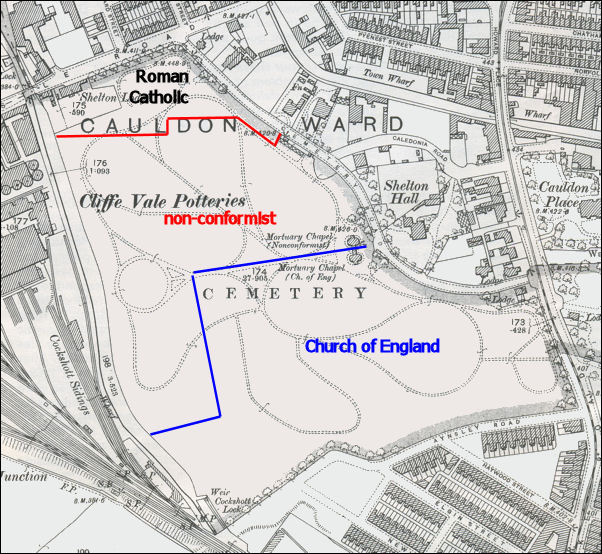|
The division of
the cemetery
Following the same
system as Hartshill and Burslem cemeteries there are two chapels one
for non-conformists and one for Church of England.
Also the layout of the
graves was in difference classes (1st, 2nd, 3rd and 4th divisions)
and also different denominations - Church of England, Non-conformist
and Roman Catholic.

1898 OS map showing
the division of Hanley cemetery
THE GRAVE BLOCK PLAN
Hanley Borough Cemetery, like other Victorian cemeteries,
operated at four different levels.......
1) At one level was the formal plan of walks and the
accompanying trees and shrubs shown on the OS map.
2) At another level the cemetery was divided into a block
plan which originally contained 129 blocks. When the cemetery was
extended in 1874 and the land originally intended for villas
residences fronting the main roads was incorporated into the site
the number of blocks was increased to 189. There were 200 grave
spaces in each block which was divided into 10 rows with 20 graves
per row. Each grove was 9 feet long by 4 feet wide. This ensured
that when the grave was excavated there was ample solid ground on
either side.
3) At a third level, the cemetery was divided on religious
lines: 6 1/2 acres were set aside for the Church of England, 6 1/2
acres for Dissenters, and two acres for Roman Catholics. The lines
on the plan above shows the division between each denomination.
4) The classes of graves - the cemetery was also split
into four classes of plots: 1st, 2nd, 3rd and 4th class ground. The
first class plots were situated in the most prominent position,
around the cemetery chapels, and on the highest ground.
The second class plots were immediately adjacent occupying the
middle part of the cemetery.
The third class graves were on the lowest and most badly drained
land adjacent to the Trent and Mersey Canal.
Fourth class ground was used for burials at the expense of the
parish.
There were at least three different grave sizes for classes 1 to
3.
For example, burial in a 1st class ground in a vault space 9ft X
4ft including the making of a vault to contain no more than three
bodies cost £14. However, an identical burial in 1st class ground
but with a 9ft X 8ft vault cost £24. Second class burials cost
less than 1st class - a vault space 9ft X 4ft including the making
of a vault containing no more that 3 bodies cost £9 12s. Third
class cost less than 2nd but the purchasers of grave spaces in
this class of ground had no choice in the site.
Andrew
Dobraszczyc's notes

|
![]()
![]()
![]()